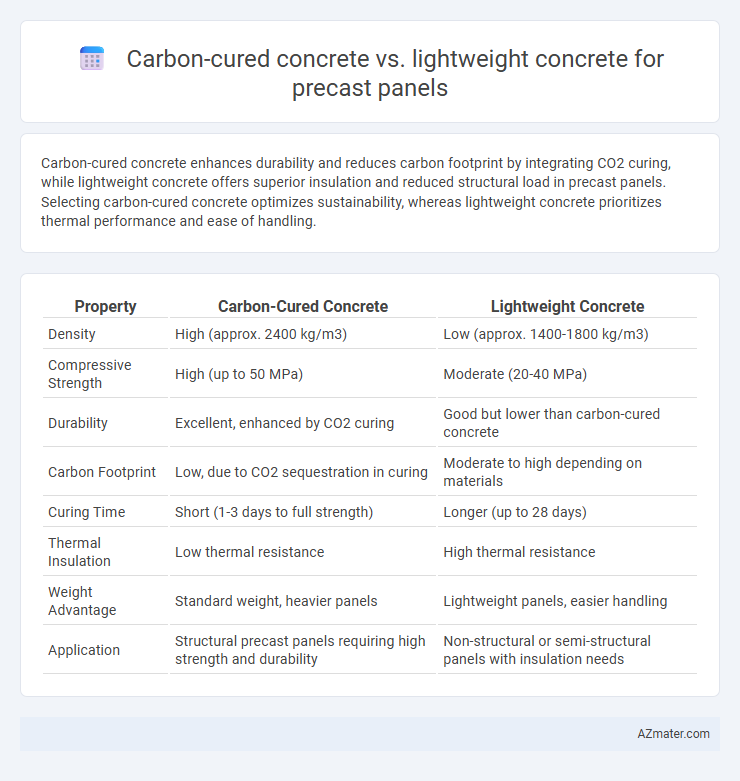Carbon-cured concrete enhances durability and reduces carbon footprint by integrating CO2 curing, while lightweight concrete offers superior insulation and reduced structural load in precast panels. Selecting carbon-cured concrete optimizes sustainability, whereas lightweight concrete prioritizes thermal performance and ease of handling.
Table of Comparison
| Property | Carbon-Cured Concrete | Lightweight Concrete |
|---|---|---|
| Density | High (approx. 2400 kg/m3) | Low (approx. 1400-1800 kg/m3) |
| Compressive Strength | High (up to 50 MPa) | Moderate (20-40 MPa) |
| Durability | Excellent, enhanced by CO2 curing | Good but lower than carbon-cured concrete |
| Carbon Footprint | Low, due to CO2 sequestration in curing | Moderate to high depending on materials |
| Curing Time | Short (1-3 days to full strength) | Longer (up to 28 days) |
| Thermal Insulation | Low thermal resistance | High thermal resistance |
| Weight Advantage | Standard weight, heavier panels | Lightweight panels, easier handling |
| Application | Structural precast panels requiring high strength and durability | Non-structural or semi-structural panels with insulation needs |
Introduction to Precast Concrete Panels
Precast concrete panels are widely used in construction for their durability, versatility, and efficiency, with Carbon-cured concrete and Lightweight concrete representing two advanced material options. Carbon-cured concrete enhances sustainability by utilizing CO2 during the curing process, leading to increased strength and reduced carbon footprint compared to conventional curing methods. Lightweight concrete offers reduced panel weight and improved thermal insulation, making it ideal for applications requiring ease of handling and energy efficiency in building envelopes.
Overview of Carbon-Cured Concrete
Carbon-cured concrete utilizes carbon dioxide curing technology to enhance the strength and durability of precast panels by accelerating the carbonation process, which converts calcium compounds in the concrete into stable calcium carbonate. This method reduces the carbon footprint of the production process by sequestering CO2, improves early-age strength, and results in higher density and reduced porosity compared to traditional lightweight concrete. As a result, carbon-cured concrete panels offer superior structural performance and sustainability benefits over conventional lightweight alternatives in precast applications.
Understanding Lightweight Concrete
Lightweight concrete used in precast panels offers enhanced thermal insulation, reduced structural load, and improved fire resistance compared to traditional carbon-cured concrete. Its lower density, achieved by incorporating lightweight aggregates such as expanded clay or shale, allows for easier handling and transportation without compromising strength. Understanding these properties helps optimize panel performance in building applications where weight and energy efficiency are critical factors.
Key Differences Between Carbon-Cured and Lightweight Concrete
Carbon-cured concrete for precast panels undergoes accelerated carbonation curing, which significantly enhances compressive strength and durability by chemically binding CO2 within the concrete matrix, while lightweight concrete primarily reduces density and thermal conductivity through the use of lightweight aggregates such as expanded clay or pumice. Carbon-cured concrete offers superior environmental benefits through CO2 sequestration, whereas lightweight concrete focuses on improving structural efficiency by decreasing dead load and improving insulation properties. Key differences lie in their curing process, density, mechanical strength, thermal performance, and sustainability impact, making carbon-cured concrete more suitable for high-strength, eco-friendly panels and lightweight concrete ideal for applications demanding reduced weight and enhanced thermal insulation.
Strength and Durability Comparison
Carbon-cured concrete demonstrates superior early strength development and enhanced durability due to accelerated carbonation, resulting in denser microstructure and reduced permeability compared to lightweight concrete used in precast panels. Lightweight concrete offers benefits in reduced weight and thermal insulation but generally exhibits lower compressive strength and greater susceptibility to cracking under load and environmental exposure. For precast panels requiring high structural performance and long-term durability, carbon-cured concrete provides a more robust solution with improved resistance to freeze-thaw cycles and chemical attacks.
Sustainability and Environmental Impact
Carbon-cured concrete for precast panels reduces CO2 emissions by capturing and permanently storing carbon dioxide during the curing process, significantly lowering the carbon footprint compared to traditional methods. Lightweight concrete offers enhanced thermal insulation and reduced material consumption, contributing to lower embodied energy and improved energy efficiency in building applications. Sustainable construction benefits from carbon-cured concrete's carbon sequestration capabilities and lightweight concrete's energy-saving properties, positioning both materials as eco-friendly alternatives in precast panel production.
Cost Considerations
Carbon-cured concrete offers cost savings through faster curing times and reduced energy consumption compared to traditional methods, which can lower overall production expenses for precast panels. Lightweight concrete, while slightly more expensive in raw materials due to aggregates like expanded shale or clay, reduces transportation and handling costs because of its lower density. Evaluating the total lifecycle cost, including curing efficiency and structural requirements, is essential for choosing the most cost-effective option between carbon-cured and lightweight concrete in precast panel manufacturing.
Installation and Construction Techniques
Carbon-cured concrete for precast panels offers accelerated curing times through CO2 injection, enabling faster installation and reduced construction timelines compared to lightweight concrete panels. Lightweight concrete panels provide easier handling and transportation due to lower density, but may require specialized anchoring systems and additional framing adjustments on site. Both materials demand precise alignment and secure joint sealing, although carbon-cured panels benefit from enhanced early strength, allowing quicker post-installation load application.
Applications in Modern Construction
Carbon-cured concrete enhances durability and reduces carbon footprint, making it ideal for eco-friendly precast panels in sustainable building projects. Lightweight concrete offers superior thermal insulation and reduced structural load, benefiting high-rise and modular construction where weight efficiency is critical. Both materials optimize precast panel performance, with carbon curing advancing environmental compliance and lightweight concrete improving energy efficiency.
Choosing the Right Concrete for Precast Panels
Carbon-cured concrete enhances durability and reduces curing time through CO2 injection, making it ideal for sustainable precast panels with superior strength and lower carbon footprint. Lightweight concrete offers benefits in thermal insulation and reduced structural load, improving transportation efficiency and ease of installation for large precast elements. Selecting the right concrete depends on project priorities such as environmental impact, load requirements, and panel performance demands.

Infographic: Carbon-cured concrete vs Lightweight concrete for Precast panel
 azmater.com
azmater.com